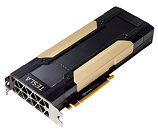- Joined
- Oct 9, 2007
- Messages
- 47,696 (7.42/day)
- Location
- Dublin, Ireland
| System Name | RBMK-1000 |
|---|---|
| Processor | AMD Ryzen 7 5700G |
| Motherboard | Gigabyte B550 AORUS Elite V2 |
| Cooling | DeepCool Gammax L240 V2 |
| Memory | 2x 16GB DDR4-3200 |
| Video Card(s) | Galax RTX 4070 Ti EX |
| Storage | Samsung 990 1TB |
| Display(s) | BenQ 1440p 60 Hz 27-inch |
| Case | Corsair Carbide 100R |
| Audio Device(s) | ASUS SupremeFX S1220A |
| Power Supply | Cooler Master MWE Gold 650W |
| Mouse | ASUS ROG Strix Impact |
| Keyboard | Gamdias Hermes E2 |
| Software | Windows 11 Pro |
NVIDIA formally announced the PCI-Express add-on card version of its flagship Tesla V100 HPC accelerator, based on its next-generation "Volta" GPU architecture. Based on the advanced 12 nm "GV100" silicon, the GPU is a multi-chip module with a silicon substrate and four HBM2 memory stacks. It features a total of 5,120 CUDA cores, 640 Tensor cores (specialized CUDA cores which accelerate neural-net building), GPU clock speeds of around 1370 MHz, and a 4096-bit wide HBM2 memory interface, with 900 GB/s memory bandwidth. The 815 mm² GPU has a gargantuan transistor-count of 21 billion. NVIDIA is taking institutional orders for the V100 PCIe, and the card will be available a little later this year. HPE will develop three HPC rigs with the cards pre-installed.

View at TechPowerUp Main Site

View at TechPowerUp Main Site





